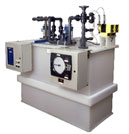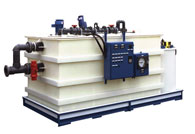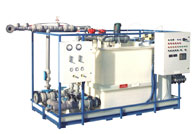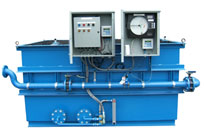Nitric (HNO3) Acid Neutralization
Nitric Acid is commonly used in the production of
fertilizers, explosives, fireworks, in metal plating & finishing, in
the production of chemicals, and in mining. Nitric and
Hydrochloric acid are often used in combination to form Aqua Regia which
is commonly used in both the semiconductor industry as well as in
mining. While nitric can be used for pH
neutralization there are better choices.
Nitric acid is colorless, very
aggressive, and a strong oxidant with the ability to dissolve many materials.
HNO3 also
presents some very serious environmental health and safety issues
and will attack skin and all organs. Reactions involving HNO3
and the decomposition of nitric can liberate toxic nitrous oxide
gasses and reactions with organic materials and nitric can result in
violent or explosive reactions owing to the oxidation power of
nitric acid.
HNO3 , as with any acid, must be neutralized before an effluent
wastewater stream is discharged.
Nitric Acid ( HNO3 )
Nitric Acid HNO3:
With a pKa of zero (or nearly so) HNO3 is a very strong
acid that fully disassociates at all concentrations. At higher
concentrations (>5%) the outgassing of HNO3 can be quite significant
and good ventilation is required. The pH neutralization of Nitric acid is
conventional and any inorganic base such as
sodium hydroxide or
lime
can be used.
Nitric acid is a one normal solution which means that for each mole of HNO3 one mole of H+ or acid is liberated requiring one mole of
hydroxide (OH-) to neutralize.
One mole of
sodium hydroxide (NaOH) is required to neutralize one mole of HNO3 , as follows:
NaOH + HNO3 → NaNO3 + H20
Conversely one mole of lime as Ca(OH)2 will neutralize two moles of HNO3 resulting in calcium nitrate, a salt:
Ca(OH)2 + 2HNO3 → Ca(NO3)2 + 2H20
Heat of Neutralization
All pH neutralization reactions are exothermic and heat will be released. In most practical applications the acid concentration is too low for the temperature rise to be a concern, however, as the concentration of acid increases above about 1% the temperature rise is not only measureable but can be of concern.
ΔHN = 55.83 KJ / Mole of H+
For example, neutralizing a 10% solution of HNO3 acid will yield a temperature rise of nearly 200C while neutralizing a 70% solution of concentrated Nitric acid will yield a temperature rise of over 1200C. This is enough to meltdown any thermoplastic piping system and hot enough to cause steam explosions.
Our concentrated acid pH neutralization systems take into account the known temperature rise and measures are taken to control this by continuous temperature monitoring, reaction rate control and, when required, the addition of quench water. An example of a concentrated acid pH neutralization system can be seen at: Battery Acid Neutralization
Precipitation Products
The pH neutralization of any strong acid with a strong base will produce a salt. When one of the reactants is relatively dilute the products of
neutralization will remain soluble, particularly if sodium (Na) is the cation. However, if the cation is calcium (Ca) or if the concentration of both reactants is
elevated then precipitation products (insoluble salts) will begin to form. In
most cases these can simply be discharged to the drain.
Digital Analysis Corp. manufactures a complete line of pH neutralization systems for the neutralization of
Nitric acid (HNO3) and all mineral acids, bases, organic acids, and alkalis.
Three of our four families of effluent pH neutralization systems are
well suited for the neutralization of nitric bearing effluent wastewater
and these include our pHASE,
labTREAT, and
batchTREAT families of pH
neutralization systems.
Packaged / Skid Mounted pH Neutralization Systems
Digital Analysis manufactures four families of pH adjustment
systems.
These include: pHASE, labTREAT, batchTREAT, and hydroTREAT

pHASE Family of pH Adjustment systems are batch systems designed to handle continuous flows from 0-60 GPM. The pHASE family is capable of handling a variety of wastewater influent streams ranging from highly acidic to highly alkaline.
- Continuous flows from 0-60GPM
- Compact platform
- Bi-directional: neutralize acids and bases.
- Batch system design.
- Will handle concentrated acids and bases.
- Completely Automated

labTREAT Family of pH Adjustment systems are continuous flow through systems designed to handle continuous flows from 0-300 GPM. The labTREAT family is capable of handling a variety of wastewater streams from industrial and institutional research laboratories.
- Continuous flows from 0-300GPM
- Available in one, two, and three stage designs.
- CIP neutralization - well suited for hot CIP wastes.
- Bi-directional: neutralize acids and bases.
- Continuous flow through system design.
- Will handle high flows in a minimal footprint.
- Completely Automated

batchTREAT Family of pH Neutralization systems are designed to handle continuous flows of industrial wastewater from 0-10,000 GPM. This large platform system is a batch system that handles continuous flows that can be highly acidic or highly alkaline.
- Continuous flows from 0-1,000GPM
- Many options including duplex / redundant pH system design.
- Bi-directional: neutralize acids and bases.
- Batch system design.
- Will handle concentrated acids and bases.
- Completely Automated

hydroTREAT Family of pH Neutralization systems are specifically designed for alkaline / high pH influent flows, particularly wastewater from concrete and hydrodemolition applications. The hydroTREAT family is designed to use carbon dioxide (CO2).
- Continuous flows from 0-1,000GPM
- Concrete wastewater - Designed specifically for concrete wastes, hydro-demolition wastewater, and tunneling wastewater and runoff.
- Does not require the use of hazardous chemicals such as concentrated acids.
- Safe carbon-dioxide (CO2) usage.
- Designed for outdoor use on unimproved surfaces.
- Completely Automated
